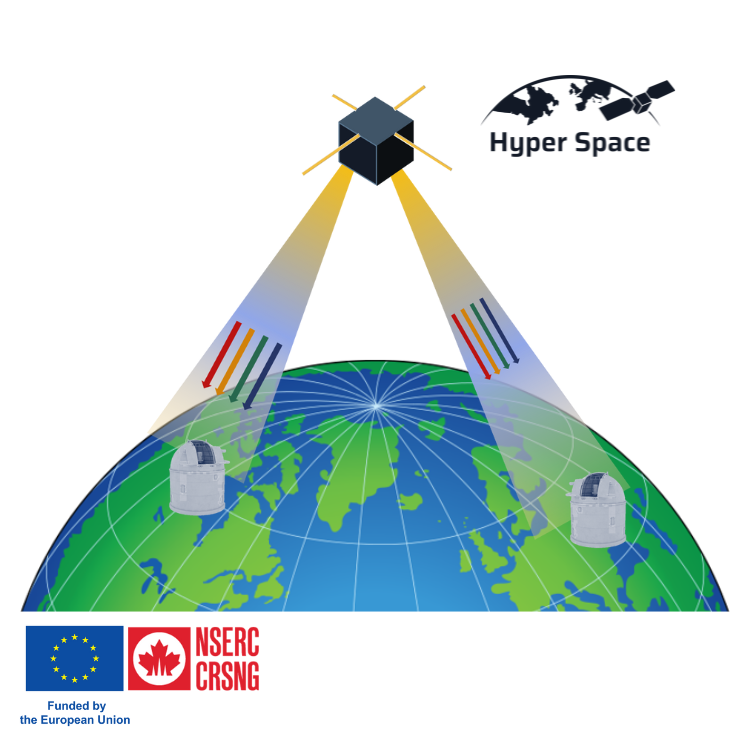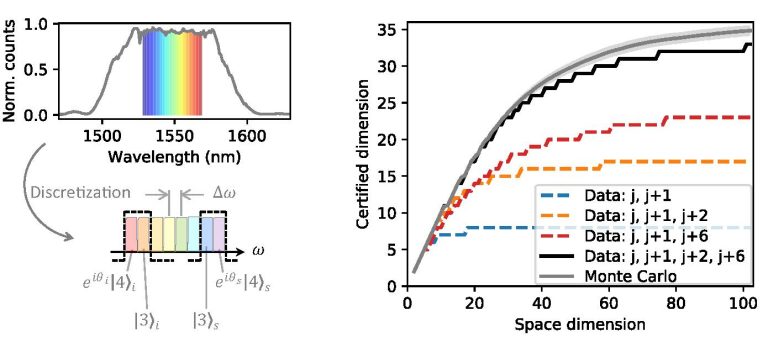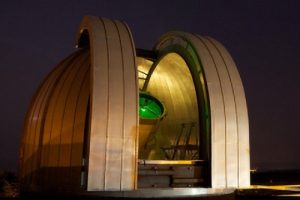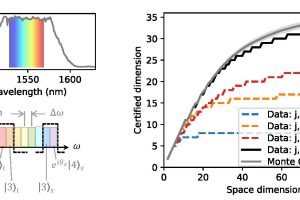HyperSpace project: joining efforts of European and Canadian institutes towards a global Quantum network
Quantum entanglement is a phenomenon that fascinates scientists around the world. The very idea that two particles are intimately bound together and that a change of state in one instantly causes a change in the other, even if they are millions of light years apart, remains intriguing. This action, once described by the theoretical physicist Albert Einstein as „spooky action at a distance“, is now the basis for applications in information processing and detection. Entangled photons have already been successfully exchanged over short distances in various experiments using free beams in the air or via optical fibres laid in the ground. However, the exchange over longer distances still presents technological challenges.
The solution: the direct exchange of entangled photons in space via optical satellite links. Within HyperSpace, a team of scientists from Europe and Canada will study the distribution of complex (high-dimensional) entangled photons via satellite. It paves the path to take quantum communication research to a whole new level and to solve together technological challenges whose results will benefit society. The overarching goal of HyperSpace is to further develop satellite-based quantum communications by appropriate experiments into scalable global quantum networks. This global quantum network will interconnect a wide range of quantum processors using a variety of quantum channels, just as in the conventional Internet.
Discover HyperSpace on the Information Page of the European Commission CORDIS: HyperSpace on CORDIS
Work performed and main achievements:
Reaching the half-time of the project, 4 milestones were successfully reached. A report on the mission requirements was finalized including the specification of satellite-compatible sources. A realistic noise-model was developed. For more information on „How to harness high-dimensional temporal entanglement, using limited interferometry setups“ please read the paper at https://arxiv.org/abs/2308.04422.
Bringing high-dimensional photonic entanglement a step forward, a record certification of discretized frequency entanglement, combined with a novel approach for certification that is both highly efficient and nonlocally implementable was achieved within the framework of HyperSpace: „High-Dimensional Entanglement for Quantum Communication in the Frequency Domain“ (https://doi.org/10.1002/lpor.202201010).

HYPERSPACE PROJECT PARTNERS WILL MEET IN MARCH
The next project meeting will take place in Pavia in March.
Challenge: Overcoming large distance in Quantum communication
HyperSpace aims to extend the hitherto untapped potential of high-dimensionally entangled photons to long-distance free-space communications. Encoding multiple qubits on individual photons via d-level quantum properties – qudits – increases channel capacity and yields benefits for the implementation of advanced quantum information processing (QIP), such as improving resilience with respect to noise and eavesdropping in quantum key distribution (QKD). To facilitate deployment on scalable small satellites, the team seeks not only to develop new protocols based on quantum hyperentanglement, but also to transfer these protocols into scalable photonic integration platforms.

Possible applications
Applications of HyperSpace in the field of information technology and sensors will be extensive. For instance, a global quantum internet will enable significantly improved applications, such as more accurate clock synchronization, highly efficient cloud information, or even highly secure data transmission through quantum cryptography that relies on physics. Some of these applications were previously not imaginable.
References:
Work performed and main achievements
Start of project with virtual kickoff meeting on October 5th, 2022.
First virtual technical meetings of WP1, WP2 and WP5: exchange of contributions of all partners to WP1, WP2, and WP5 including first progress reports and planned actions. Bilateral exchanges ongoing.
Source developments for the generation of time-energy entangled photon pairs based on a silicon photonic crystal cavity, implemented in a fully CMOS-compatible platform have been published in Barone, Andrea, et al. APL Photonics 9.1 (2024). A record in certification of frequency entanglement has been shown in (Cabrejo et al) and noise-resilient protocols for high-dimensional QKD have been developed in (Bergmayr et al).
Objectives
The adoption of quantum communication on continental and transcontinental scale will be facilitated by achieving the following concrete objectives, which will be developed thanks to the continuous interconnections of EU/CAN organizations.
- Demonstrate integrated sources of photon pairs with 1 Gpair output
- Demonstrate integrated sources of high-dimensional and hyper-entangled quantum states
- Successful transmission and analysis of high-dimensional quantum states in free-space links
- Development of novel quantum protocols for multiple qubits via the use of multiple degrees of freedom
- Establish a technology roadmap towards satellite-based network linking Canada and Europe
- Ensure wide dissemination and exploitation of the achieved results among research centers, industrial end users and stakeholders, relevant clusters and CAN/EU entities





